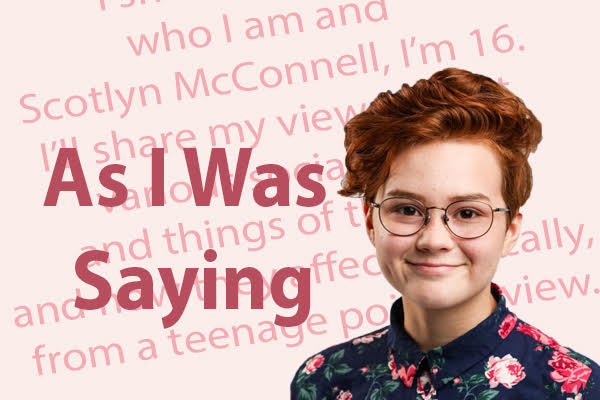
By Scotlyn McConnell
Dress codes are a hot topic in the news right now, but it seems to me that there’s something wrong with all of the articles: They are all written by adults who aren’t directly affected by public school dress codes.
Before I begin, I would like to point out that I’m only going to be talking about dress codes where children can wear what they like and not uniforms, since that is a whole other topic.
Now, my stance on dress codes is this: I simply don’t like them. However I recognize that isn’t a sufficient argument as to why, in my own opinion, dress codes are bad, so I’ll elaborate.
In the majority of public schools in America, there is a dress code. The dress code ranges from reasonable things, like no genitalia should be visible, or no undergarments, excluding straps and waistbands, should be seen, to the utterly ridiculous. By “utterly ridiculous” I mean schools where girls can’t show their collarbones, or can’t wear leggings or yoga pants because they are too tight.
This raises our first issue: These things are completely gendered. Everything is directed towards girls and creates a sexist dress code. While boys walk around school in shirts where the sleeves are cut down to the hem and you can see straight through it, girls need to be covered up to the neck at all times. In fact, most dress codes look like this, “Girls’ dress code: Shoulders, collarbones, midriff, bra straps and cleavage must be covered. Shirt sleeves must be the width of three fingers. Skirts, shorts and dresses must be middle fingertip length, and pants must be loose enough so that an outline of any private areas cannot be seen. No holes in pants that are above the knee. Makeup should not be excessive.”
This is vastly different from boys’ dress codes, which are usually something like, “Boys’ dress code: Boys should not have sagging pants or have any genitalia visible. Must not wear studded belts or cuffs, no chain wallets, must be well groomed.” Of course there’s also the general dress code at some schools that forbid hats or head coverings, which means that even if you wear something for religious reasons, such as a hijab, it wouldn’t be allowed.
Every adult that I’ve ever talked to about dress codes has at one point brought up that dress codes need to be in place because boys and teachers might get distracted or feel uncomfortable. Let that statement sink in for a moment.
First, may I just say, ew. The idea of a teacher getting distracted or feeling uncomfortable by my thighs mildly disturbs me. Second, saying the part about boys has a couple of different issues wrapped inside of it. The first issue is that this edict assumes boys are wild animals who cannot control themselves when a girl’s shoulder is all out and about. The second issue is that this places a boy’s education above a girl’s. By saying that a girl needs to dress a certain way or she will be punished (this usually means pulling her out of class or making her go home) because of a boy, you are saying that his education is more important and, ultimately, so is he.
Another argument that is brought up a lot is that having a dress code means there are less discipline violations. This isn’t true, especially with stricter dress codes. The more elaborate the code is, the harder it is to follow. As soon as you put another rule in place, especially one that conflicts with a teenager’s closet, there are going to be people breaking it whether it’s on purpose or not.
Something else I would like to bring up is that what dress codes forbid is almost our entire closets, excluding that pair of bootleg jeans we have shoved in the bottom drawer and a t-shirt. It’s like everyone needs two closets, one for clothes you actually like, enjoy wearing and feel confident in, and one for clothes you can wear to school.
It doesn’t help that sometimes it’s hot outside. Actually, a lot of the time it’s hot outside in Southern Indiana, and it’s very unpleasant to have sweaty inner thighs and pit stains, but since we can’t wear shorts that are comfortable or tank tops, I guess we’re stuck (and sticky).
An issue that I’ve come across at my own school is the vagueness of our dress code and the fact that it’s completely subjective. As of now, our dress code has no clear guidelines and only states that “a learner can dress in what makes them comfortable as long as it isn’t deemed a safety concern or distraction.” The fact that this leaves it up to how a teacher or student feels about what I’m wearing is a problem.
For example, I wore a pair of shorts to school on four separate occasions, and they were absolutely fine. But, recently, I wore them and a fellow student decided to report me because they deemed my shorts “inappropriate.” Fortunately, though, a few other students and I have started a conversation and are in the process of making a new dress code that follows that of the Portland, Ore., public school system. We’re hopeful we’ll be able to get approval to include a revised, clarified dress code in our student handbook soon.
Dress codes in whole are a very grey area and I understand that we can’t fix everything overnight. I also understand that there will always be people who disagree with me and want to keep dress codes. This is all fine, but obviously there’s more than one point of view. This was mine, the point of view of a teen who is being affected by a dress code.














